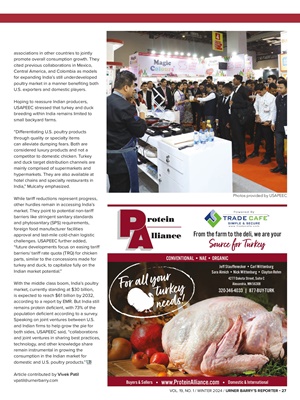
VOL. 19, NO. 1 / WINTER 2024 / URNER BARRY'S REPORTER • 27
Jeff Stauffenecker • Carl Wittenburg
Sara Almich • Nick Wittenburg • Clayton Rehm
4277 Dakota Street, Suite C
Alexandria, MN 56308
320-346-4033 | 877-BUY-TURK
Buyers & Sellers • www.ProteinAlliance.com • Domestic & International
From the farm to the deli, we are your
Source for Turkey
CONVENTIONAL • NAE • ORGANIC
For all your
turkey
needs!
associations in other countries to jointly
promote overall consumption growth. They
cited previous collaborations in Mexico,
Central America, and Colombia as models
for expanding India's still underdeveloped
poultry market in a manner benefiting both
U.S. exporters and domestic players.
Hoping to reassure Indian producers,
USAPEEC stressed that turkey and duck
breeding within India remains limited to
small backyard farms.
"Differentiating U.S. poultry products
through quality or specialty items
can alleviate dumping fears. Both are
considered luxury products and not a
competitor to domestic chicken. Turkey
and duck target distribution channels are
mainly comprised of supermarkets and
hypermarkets. They are also available at
hotel chains and specialty restaurants in
India," Mulcahy emphasized.
While tariff reductions represent progress,
other hurdles remain in accessing India's
market. They point to potential non-tariff
barriers like stringent sanitary standards
and phytosanitary (SPS) requirements,
foreign food manufacturer facilities
approval and last-mile cold-chain logistic
challenges. USAPEEC further added,
"future developments focus on easing tariff
barriers/ tariff rate quota (TRQ) for chicken
parts, similar to the concessions made for
turkey and duck, to capitalize fully on the
Indian market potential."
With the middle class boom, India's poultry
market, currently standing at $30 billion,
is expected to reach $61 billion by 2032,
according to a report by EMR. But India still
remains protein deficient, with 73% of the
population deficient according to a survey.
Speaking on joint ventures between U.S.
and Indian firms to help grow the pie for
both sides, USAPEEC said, "collaborations
and joint ventures in sharing best practices,
technology, and other knowledge share
remain instrumental in growing the
consumption in the Indian market vpatil@urnerbarry.comd U.S. poultry products."
Article contributed by Vivek Patil
vpatil@urnerbarry.com
Photos provided by USAPEEC